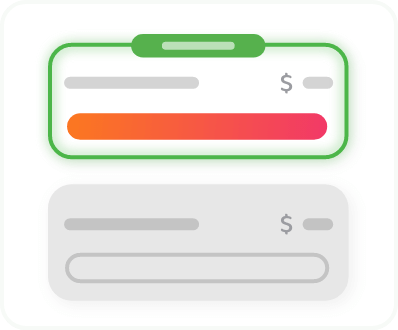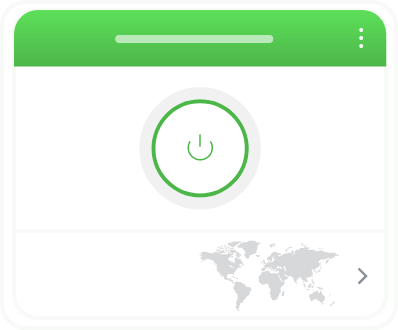TA TILLBAKA KONTROLLEN
Private Internet Access: Bästa VPN för digital integritet
- Obegränsad åtkomst till servrar världen över
- Blixtsnabb hastighet för streaming + fildelning
- Tekniska experter tillgängliga 24/7 för support


BETRODD AV FÖRETAG SOM:






30 dagars pengarna-tillbaka-garanti
Integritetsskydd
Alla behöver vi integritet, speciellt på internet. Din IP-adress och ditt surfande bördöljas från onödig övervakning. Du kan vara säker på att PIA:s virtuella privata nätverk aldrig sparar användarloggar – någonsin.


Säkra uppgifter
Håll dina uppgifter krypterade för extra säkerhet. Låt inte någon komma över okrypterade e-postmeddelanden, bilder, bankuppgifter eller annat som är bäst att hålla privat.
Fullständig åtkomst
Få åtkomst till allt ditt favoritinnehåll utan begränsningar från internetleverantören och irriterande nätverksrestriktioner. Njut av obegränsad bandbredd för att hålla dig uppkopplad till världens bästa program, appar och spel.

Förstklassiga tillägg för extra säkerhet

Integritetsfokuserat antivirus
Vår toppmoderna antivirusprogramvara skannar och tar bort skadlig programkod från din Windows-dator, utan att spåra användaraktivitet eller logga anslutningsuppgifter – vilket gör PIA till det enda antivirusprogrammet som ger dig full kontroll över dina uppgifter och din digitala integritet.

Dedikerad IP-adress
Skaffa en unik IP-adress som bara du kan använda. Detta är perfekt om du vill dra nytta av alla fördelarna med ett VPN – som att få tillgång till begränsat innehåll och dölja din aktivitet på nätet – men med färre CAPTCHA-processer och mer stabilitet när du tar itu med saker som bankärenden eller spelar spel på nätet.
Miljontals nöjda kunder litar på oss
Här är ett litet urval av våra mest positiva användaromdömen. Alla omdömen på Trustpilot finns tillgängliga här.
{"tweetsBtnText":"{Tweets}","userBtnText":"{User Reviews}","influencersBtnText":"{Influencers}","techReviewsBtnText":"{Tech Reviews}"}
Integritet på alla dina enheter
Skydda ett obegränsat antal enheter samtidigt med bara en prenumeration.


Välj den plan som passar dig bäst
3 år + 3 månader
$2.03/mån$466.05 $79 per 3 år
Faktureras vart tredje år
3 år + 3 månader
$2.03/månSpara 83%
$466.05 $79 per 3 år
Faktureras vart tredje år

Alla belopp visas i USD och alla rabatter speglar en sänkning baserat på det nuvarande priset för tjänsten på $11.95 per månad.

Få tillgång till de senaste toppmoderna funktionerna

Inga loggar
PIA spårar, registrerar eller lagrar aldrig några användaruppgifter. Användarnas integritet är själva grunden i vår verksamhet.

Öppen källkod
Våra appar har 100 % öppen källkod. Vem som helst kan inspektera och anpassa vår programvara med öppen källkod.

Avancerade uppdateringar
Private Internet Access använder de senaste och bästa krypteringsstandarderna och VPN-protokollen – som WireGuard.

Kom igång direkt
Välj din plan, ladda ner PIA VPN-appen, verifiera ditt konto och skydda dig på några minuter.

Obegränsad bandbredd
Ta del av obegränsade internethastigheter med vårt omfattande nätverk av servrar.

Blockera annonser, spårare och skadlig programkod
Bli av med annonser, spårare på nätet och skadliga webbplatser med PIA:s ”MACE”-funktion.

Ladda ner VPN till alla dina enheter!
Skydda alla dina enheter med PIA:s topprankade VPN-tjänst. Anslut till NextGen-servrar i 91 länder och upptäck snabba VPN-anslutningshastigheter.
Installera våra Windows- och Linux-appar på din dator eller använd vår macOS-app för din Mac. Ladda ner vår VPN-.apk-fil till din Android-smartphone och surfplatta, eller vår iOS-app till dina mobila Apple-enheter.
Använd våra VPN-tillägg för Chrome, Firefox och Opera för att surfa på ett säkert sätt. Du kan dessutom använda vår Smart DNS-funktion för smart-TV, spelkonsoler och routrar.

Vad är ett VPN?
Definitionen av ett VPN är ett virtuellt privat nätverk, det vill säga en tjänst som tillhandahåller en säker och krypterad internetanslutning. VPN har blivit ett populärt cybersäkerhetsverktyg de senaste åren på grund av ökningen av hot på offentliga nätverk.
PIA VPN skyddar din digitala identitet genom att omdirigera din internettrafik via privata och säkra servrar. Vi har ett stort globalt nätverk av avancerade VPN-servrar och använder de bästa VPN-protokollen på marknaden för att kryptera dina personuppgifter.


PIA:s robusta serverinfrastruktur
PIA VPN använder det öppna ramverket IPSec (IP Security Architecture) för att kryptera och autentisera information. Detta ramverk krypterar utgående uppgifter och autentiserar inkommande uppgifter. I båda fallen överförs uppgifterna via en mellanliggande säker server som hanterar all kommunikation, vilket innebär att kvaliteten på dessa servrar är avgörande.
PIA har ett nätverk av NextGen-servrar som är utformade och optimerade med de bästa hårdvarukomponenterna. Våra samlokaliserade servrar garanterar att vår infrastruktur är oåtkomlig för tredje part. Vi har dessutom uppgraderat våra servrar med 10 Gbps-nätverkskort för att möjliggöra maximala anslutningshastigheter. Dessa funktioner säkerställer att du får den säkraste och snabbaste möjliga anslutningen.
Hur fungerar ett VPN?
Ett VPN omdirigerar internettrafik, krypterar dina uppgifter och maskerar din IP-adress. Detta förbättrar din säkerhet och ökar din anonymitet
När du surfar på nätet kan din internettrafik fångas upp. Dina uppgifter är åtkomliga för din internetleverantör, nätverksadministratörer, paketanalysörer med mera. Om du omdirigerar din trafik via en fjärrserver skapas en effekt som liknar en tunnel – det som färdas genom tunneln kan inte ses av tredje part.
Att använda ett privat nätverk är fördelaktigt då det använder sig av högkvalitativ kryptering. Genom att kryptera dina uppgifter skyddar du din privata information.


Kan jag spåras när ett VPN är på?
Dina aktiviteter på nätet kan inte spåras när du använder ett förstklassigt VPN. PIA:s VPN-servrar omdirigerar och krypterar din internettrafik och maskerar din IP-adress i realtid. Genom att använda PIA kan du säkerställa att internetleverantörer, myndigheter och cyberbrottslingar inte kan övervaka dina aktiviteter på nätet och lokalisera var du befinner dig.
Genom att dölja din IP-adress hindrar du också webbplatser och spårare från att identifiera dina aktiviteter på nätet, vilket innebär att du kan förbli inkognito och kringgå nätverksblockeringar när du är ute och reser. Ett VPN är avgörande för att förbättra din anonymitet och frihet på nätet.
6 fördelar med att använda VPN

Ändra din virtuella plats
Välj din plats online genom att ansluta till PIA:s omfattande nätverk av NextGen-VPN-servrar. Nätverket omfattar 91 länder, inklusive USA:s samtliga 50 delstater.

Skydda din integritet
Dölj din IP-adress för att skydda din identitet på nätet. Hindra din internetleverantör från att hålla koll på dina online-aktiviteter. Njut av säker surfning oavsett var du befinner dig.

Njut av fullständig digital säkerhet
Säkerställ att internetleverantörer och nätverksadministratörer inte kan lagra eller sälja dina uppgifter. Skydda alla dina enheter med PIA. Njut av en privat anslutning på valfritt nätverk.

Skydd på offentliga Wi-Fi-nätverk
Offentliga nätverk utgör ett hot mot din integritet. Installera PIA på dina enheter för att förhindra nyfikna ögon eller cyberbrottslingar från att spionera på din trafik.

Säker fildelning
Maskera din IP-adress när du delar filer på nätet. Anslut till PIA och kryptera dina uppgifter när du skickar eller hanterar privata filer.

Säkra utlandsresor
När du reser utomlands kommer du att stöta på lokala innehållsbegränsningar. Anslut till PIA VPN för att komma åt appar från hemlandet på ett säkert sätt.
Vad är ett mobilt VPN?
Med ett mobilt VPN kan du upprätthålla en VPN-session även när du växlar mellan olika nätverk, till exempel mellan ditt hemnätverk och mobilnätet.
PIA VPN erbjuder mobil VPN-funktionalitet som är optimerad för att tillhandahålla en sömlös anslutning på alla enheter. Vi har användarvänliga appar för smartphones och surfplattor som är optimerade med en Kill Switch för att skydda dig från oavsiktliga dataläckor.
Skaffa PIA VPN för alla dina mobila enheter i 3 enkla steg:

Steg 1
Registrera dig hos Private Internet Access

Steg 2
Ladda ner PIA VPN-appen

Steg 3
Tryck på startknappen för att ansluta

Vad är ett VPN med öppen källkod?
Ett VPN med öppen källkod släpper källkoden offentligt så att vem som helst kan inspektera den. Genom en transparent praxis kan du uppnå en stabil och säker programvara, vilket är anledningen till att VPN-tjänster med öppen källkod är betydligt mer pålitliga.
PIA är känt som en av de bästa VPN-tjänsterna med öppen källkod. Vem som helst kan analysera våra VPN-appar och VPN-protokoll och verifiera de steg vi tar för att säkerställa en säker och sömlös anslutning. Vi använder dessutom WireGuard® och OpenVPN, två av de bästa VPN-protokollen med öppen källkod.
Kodning med öppen källkod bidrar även till att förbättra prestanda och innovation tack vare dess samarbetsinriktade natur. Genom att erbjuda öppen källkod kan PIA:s communitymedlemmar skicka in förslag.
Hur du väljer den bästa VPN-tjänsten
för just dig
Hastighet
Bra hastigheter är avgörande. Välj ett VPN med snabba, förstklassiga servrar med sömlöst stöd för streaming och gaming. PIA erbjuder ultrasnabba VPN-servrar på 10 Gbps som låter dig njuta av streaming och onlinespel utan buffring och lagg på alla dina enheter. Undvik överbelastning och trängsel med vårt omfattande globala VPN-nätverk.


Säkerhet
När det gäller säkerhet på nätet är högkvalitativ kryptering avgörande, vilket innebär att du bör därför välja ett VPN som använder de bästa krypteringsprotokollen. Detta är det enda sättet att säkerställa att internetleverantörer, nätverksadministratörer och myndigheter inte kan komma åt dina uppgifter. PIA VPN erbjuder den mest kraftfulla krypteringen på marknaden – där du kan välja mellan 128-bitars AES eller 256-bitars AES av militär kvalitet.
Integritet
Du vill ha ett VPN som skyddar din integritet. PIA har en strikt policy att inte spara loggar. Policyn granskades i en opartisk revision som utfördes av ett av de fyra stora revisionsföretagen. Vår tjänst utan loggar
har styrkts två gånger i domstol. Du kan känna dig trygg med att vi respekterar och stöder din rätt till integritet och att vi inte sparar eller lagrar dina uppgifter.


Split tunneling
Denna viktiga VPN-funktion gör det möjligt att skapa skräddarsydda VPN-anslutningsprotokoll. Om du till exempel inte vill att din banktjänst ska flagga din aktivitet som bedräglig bör du inte kontinuerligt byta IP-adress. Ställ enkelt in en ärendebaserad regel för dess specifika appar och webbplatser. PIA VPN har en avancerad split tunneling-funktion som låter dig skapa automatiserade inställningar och välja vilka appar och domäner som kan kringgå din VPN-tunnel.
Öppen källkod
När det gäller ett VPN är öppen källkod avgörande för transparens. En öppen källkod gör att du kan ta en titt under huven och se hur ett VPN egentligen fungerar. PIA VPN är den bästa VPN-tjänsten med öppen källkod. Du kan själv inspektera vår källkod och se vilka åtgärder vi vidtar för att säkra din trafik och dina uppgifter.


Avancerat och praktiskt skydd
Om du känner att du behöver ett extra lager av skydd bör du välja ett VPN med multi-hop-funktion. Denna funktion, även känd som dubbelt VPN, gör det möjligt att länka din anslutning genom två VPN-servrar, öka din anonymitet och kringgå censur. Med PIA:s multi-hop-funktion kan du omdirigera din internettrafik genom ett VPN med endast 2 RAM-minnen som vi har utformat för att förhindra lagring av uppgifter och skydda ditt digitala fotavtryck.
Kostnad
Du vill inte kompromissa när det gäller din integritet och säkerhet på nätet. Välj ett pålitligt och högkvalitativt VPN med ett rimligt pris. PIA VPN är prisvärt och pålitligt. Våra planer erbjuder bäst valuta för pengarna. Prenumerera för endast per månad – helt riskfritt med vår 30-dagars pengarna-tillbaka-garanti.


Är VPN-tjänster lagliga?
Ja, VPN är helt lagligt i de flesta länder runt om i världen. Faktum är att de flesta regeringar förstår behovet av bättre datasäkerhet på nätet och stöder VPN som ett säkerhetsverktyg för konsumenter. Vissa länder har dock en annan uppfattning och tillåter endast medborgare att använda statligt godkända VPN-tjänster som kan innehålla övervakningsfunktioner.
Även om fler beslutsfattare och individer börjar förstå vikten av integritet på nätet är internet ännu inte en säker och fri plats. Du behöver ett högkvalitativt VPN för att skydda din digitala identitet, hålla dina uppgifter privata och njuta av ett fritt och säkert internet.
Kan jag använda ett gratis VPN?
Du kan använda ett gratis VPN, men det är inte rekommenderat. De flesta gratis VPN-tjänster har ett antal vanliga problem relaterade till kvalitet och säkerhet.
De flesta gratis VPN-tjänster har färre serverpositioner på grund av budgetbegränsningar. Detta innebär att deras servrar vanligtvis är överfulla och långsamma, och de kanske inte har en server i ditt land.
Det andra problemet är att de flesta gratis VPN-tjänster har äldre servrar. Att använda föråldrad hårdvara kan leda till sårbarheter för cyberattacker och orsaka anslutningsproblem.
De flesta gratis VPN-tjänster tjänar pengar genom att sälja användarnas uppgifter, visa annonser i appen eller både och. Detta är ett stort problem eftersom huvudmålet med att använda ett VPN är att skydda din integritet...
Undvik dessa problem genom att prova ett prisvärt och pålitligt VPN som PIA. Vi använder oss av ultrasnabba NextGen-servrar i 91 länder, de bästa VPN-protokollen för kryptering och följer en strikt policy att inte spara loggar.
.png)
Vill du veta mer?
Ett VPN är ett cybersäkerhetsverktyg som hjälper dig att skydda din digitala identitet och dina uppgifter. Det har också många andra fördelar som snabba VPN-hastigheter för sömlös surfning, kringgående av långsamma anslutningar, åtkomst till ditt favoritinnehåll på ett säkert sätt när du reser och förhindrande av cyberattacker som DDoS- och Man-in-the-Middle-attacker.
Du är inte helt anonym med ett VPN, men du kan öka din anonymitet på nätet med ett förstklassigt VPN. Med PIA kan du kryptera din internettrafik och maskera din IP-adress för att återfå din digitala integritet. Genom att dölja din unika IP-adress kan du säkerställa att din internetleverantör och andra tredje parter inte kan spåra dina aktiviteter tillbaka till dig.
En policy att inte spara loggar innebär att ditt VPN inte samlar in eller lagrar dina uppgifter. Du kanske skulle tro att detta är en självklarhet för en integritetsfokuserad tjänst, men så är tyvärr inte fallet. Vissa tjänster tjänar pengar på att spara användarnas loggar och sälja deras uppgifter. Om du vill uppleva en verkligt privat internetupplevelse behöver du ett VPN med en strikt policy att inte spara loggar, som PIA.
Ett förstklassigt VPN kommer inte att sakta ner din internetanslutning. Det kan till och med förbättra dina hastigheter när din internetleverantör tillämpar bandbreddsbegränsning under streaming eller onlinespel. PIA har till exempel ultrasnabba servrar och använder de mest effektiva VPN-protokollen, vilket innebär att du kan njuta av onlinevärlden i full hastighet, utan lagg eller krångel.
Du kan använda ditt VPN 24/7 så länge du har ett VPN utan bandbreddsbegränsningar. De flesta VPN-tjänster har bandbreddsbegränsningar, men inte PIA. Använd PIA för att maskera din aktivitet på nätet och kringgå din internetleverantörs innehållsbaserade bandbreddsbegränsning. Streama, spela eller surfa privat på webben så mycket du vill.
Du kan ställa in ditt VPN på vilken enhet som helst om du har lämpliga VPN-appar. PIA har egna VPN-appar för alla större operativsystem - macOS, Windows, Linux, Apple iOS och Android. Du kan även använda PIA på dina enheter i hemmet, till exempel din router och Smart TV. Samtliga appar är enkla att installera och använda. Med bara 1 PIA-prenumeration kan du skydda ett obegränsat antal enheter samtidigt.
VPN varierar mycket i pris mellan olika varumärken och planer – vissa är gratis och andra är mycket dyra, men bara ett fåtal är både rimligt prissatta och pålitliga. PIA VPN är ett prisvärt och pålitligt alternativ. Prenumerera på vårt erbjudande för endast per månad och ta del av vår fantastiska 30-dagars pengarna-tillbaka-garanti.
Ladda ner vårt Chrome VPN-tillägg för att skydda din Chromebook i skolan eller på andra platser. Det är enkelt att installera, ger tillgång till annonsblockeraren PIA MACE och fungerar sömlöst på ChromeOS. Du kan även ställa in PIA Smart DNS på din Chromebook – se vår supportportal för en steg-för-steg-guide.
Inte övertygad än? Ladda ner PIA VPN riskfritt
Du omfattas av vår 30-dagars pengarna-tillbaka-garanti. Om du inte är nöjd är det bara att begära full återbetalning.

